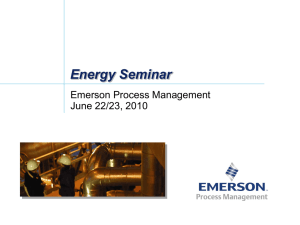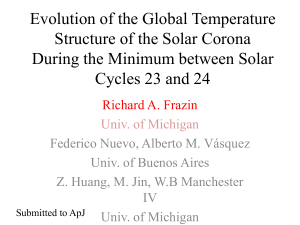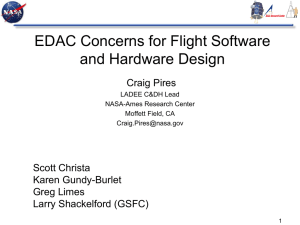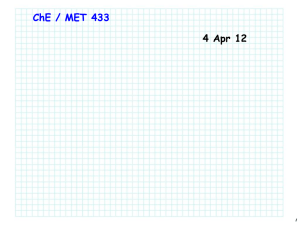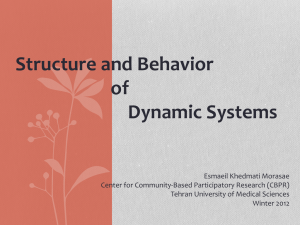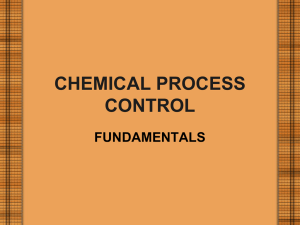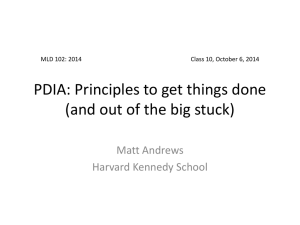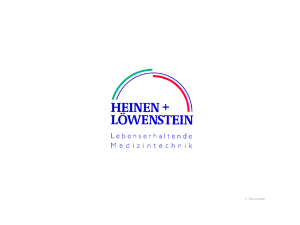12. Enhancing Paper Mill Performance through Advanced
advertisement
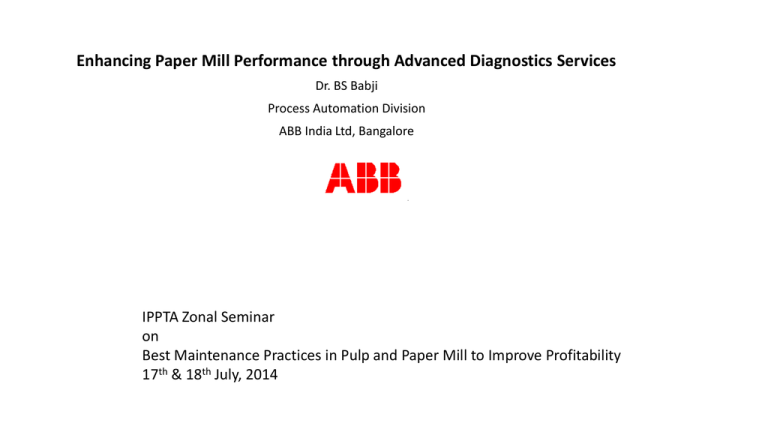
Enhancing Paper Mill Performance through Advanced Diagnostics Services Dr. BS Babji Process Automation Division ABB India Ltd, Bangalore IPPTA Zonal Seminar on Best Maintenance Practices in Pulp and Paper Mill to Improve Profitability 17th & 18th July, 2014 Outline Introduction Advanced Performance Diagnostics Platform Control Loop Performance Improvement Services Summary 4/13/2015 2 Introduction Reliable and consistent equipment are needed to • Reduce energy consumption • Minimize downtime • Optimal use of raw material DCS, QCS and Drives are important assets of a paper mill Traditional Maintenance methods are inadequate Need Maintenance strategies that are: • Proactive and Predictive • Quick and timely resolution of issues • Cost effective Advanced Diagnostics Services are available to address such maintenance needs of Pulp and Paper mills. 4/13/2015 3 Advanced Diagnostics Services Methodology Mill performance decreases over a period of time Pro-Active, not Re-Active Diagnose • Measure performance gap • ROI Estimation • Prepare action plan Implement • Apply corrective actions • Improve Performance Sustain • Manage Performance gap • Diagnose • Implement • Condition monitoring Measure and Reduce Performance Gap and sustain it through the plant life cycle 4/13/2015 4 Advanced Performance Diagnostics Platform Features: Service Experts Automatic data collection and analysis Multiple Applications • DCS • Control Loops • QCS • Drives Archiving of the information • Benchmarking • Planning maintenance schedules Secure Remote Connection Advanced Service Delivery Platform Performance Applications • Equipment • Process Local Users DCS QCS Drives Remote Connectivity 4/13/2015 5 Control Loops Performance Simple PID utilization PID Controller • Important assets in a pulp and paper mill • Includes both hardware and software PID Controllers are designed to: Regulate the process Reduce product quality variations Improve operations However, it is observed that PID Loops : are not being maintained are standing in the way of production and performance. 4/13/2015 15% 30% 35% 25% Manual Operation Output Out of range Increasing Variability Improving process 6 Control Loops Perfromance Deterioration Change in process characteristics • Process behavior changes with time as compared to original design. • Plants are modified, debottlenecked or added with new equipment • Equipment fouling, varying plant loads, seasonal changes Operations • Operator do not operate some loops in their design mode of operation due to various reasons Control valve problems • Hysteresis, stiction, nonlinear characteristics and Valve sizing PID Tuning parameters • • 4/13/2015 Many times default parameters are used Parameters unchanged after initial commissioning 7 Loop Performance Diagnosis example : oscillating loops cycling load Valve stiction F FC tight tuning Oscillation could be due to: • Controller is tuned too aggressively • Control valve is affected by stiction • upstream system oscillation generating a disturbance on the loop. 4/13/2015 8 Benefits of Process Variability Reduction Increased process variability leads to • Quality problems • Increased operating costs 4/13/2015 9 Control Loops Performance Assessment Few Control Loops • Easy to evaluate Many Control Loops • Time consuming to collect data and analyze it to find the problems • Impractical to find with simple tools • Hard to interpret dependencies between control loops Challenge to handle • Increasing complexity of automation • With less technical resources Need a systematic and automated method with suitable tools. 4/13/2015 10 Control Loops Maintenance: Performance Diagnosis Diagnose issues related to Control, Process and Signal Conditioning 4/13/2015 11 Control Loops Maintenance: Performance Diagnosis Over Control Offset 4/13/2015 Error Dead Band Slow Control 12 Control Loops Maintenance: Performance Diagnosis Control Output Saturation Valve stiction 4/13/2015 Control Valve Sizing Control Valve Leakage 13 Control Loops Maintenance: Performance Diagnosis Measurement Out of range Persistent Disturbances 4/13/2015 Excessive Noise Stepout 14 Control Loops Maintenance: Implementation Examples • Prioritized Control Loops tuning • Instrumentation calibration or repair • Control Loop Configuration Enhancements • Valve and positioner repair • Base tuning prior to APC Projects Manual Operation Original Tuning (Unstable) New Tuning • Investigation of Root Cause Disturbances 4/13/2015 15 Control Loops Maintenance: Sustain Scan • Automatic data collection and diagnosis at scheduled intervals • Implement the corrections • Periodic detailed analysis of the diagnosis results for process improvements QCS Expert Remote DCS Expert Drives Expert Remote Service Secure Access Local Track Continuous Diagnostics • Continuous monitoring of key Performance Indices ( KPIs) • Send notification automatically to concerned managers User Defined Access Drives QCS DCS Advanced Diagnostics Platform for SCAN and TRACK activities 4/13/2015 16 Control Loops Maintenance: Benefits 150 0.3% Target Shift in Moisture 0.1 Target Shift in Basis Weight 150 125 Occurrence: Normal 125 100 100 Occurrence 75 50 75 50 25 25 0 0 -0.3 -0.2 -0.1 0 +0.1 +0..2 +0..3 -0.5 0.0 +0.5 +1.0 +1.5 Shifting of the targets for Moisture & Basis Weight results in Fiber and energy savings. 4/13/2015 17 Control Loops Maintenance: Benefits 3rd Section Steam Closed loop Response Before 80 75 After 62.5 10 min SP and PV SP & PV 3rd Section Steam - Closed Loop Test 70 60.0 57.5 4.2 min 65 72.5 70 Output Output 70.0 65 67.5 65.0 60 62.5 0 10 20 30 40 50 60 70 80 Data Points, Ts = 15 sec 90 100 110 120 0 250 500 750 1000 Data Points, Ts = 1 sec 1250 1500 1750 Reduced response time after tuning results in faster recovery after • sheet breaks • grade changes • start ups. This results in increased production and reduced broke. 4/13/2015 18 Summary • Proactive and predictive maintenance strategies meet the challenges of reliability and consistency of equipment in pulp and paper mills.. • Service methodology of ‘Diagnose, Implement and Sustain ‘ helps in reducing the downtime and improve the performance of assets in a mill. • Innovative service delivery platforms with sophisticated software tools are available for continuous automatic data collection and analysis to diagnose the problems in DCS, QCS and Drives.. • Control Loops are important assets in a pulp and paper mill and their performance deteriorate over a period of time due to changes in process characteristics, wear and tear, controller tuning, seasonal changes etc • Control Loop Performance Diagnostics & improvement services help in • Improving product quality, • increasing the thruput • reducing energy consumption 4/13/2015 19 Thank You 4/13/2015 20

